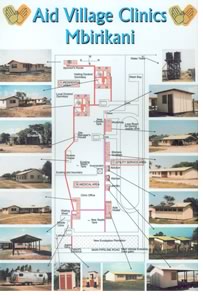

06/2005
 Hellmuth,
Obata + Kassabaum Inc., will recognize its half-century anniversary in
2005 with a half-million-dollar donation to fund the construction upgrades,
outfitting, staffing, and launch of a solar-powered diagnostic and treatment
center in rural southeastern Kenya. HOK’s $500,000 donation to
Africa Infectious Disease Village Clinics, Inc., will enable the Chicago-based
public charity to launch the most comprehensive tuberculosis diagnosis
and treatment initiative in the region, the firm reports.
Hellmuth,
Obata + Kassabaum Inc., will recognize its half-century anniversary in
2005 with a half-million-dollar donation to fund the construction upgrades,
outfitting, staffing, and launch of a solar-powered diagnostic and treatment
center in rural southeastern Kenya. HOK’s $500,000 donation to
Africa Infectious Disease Village Clinics, Inc., will enable the Chicago-based
public charity to launch the most comprehensive tuberculosis diagnosis
and treatment initiative in the region, the firm reports.
A formal dedication of the center is scheduled for October to coincide with HOK’s 50th anniversary celebration. The contribution exemplifies HOK’s long-standing commitment to enriching lives and creating more sustainable communities, says HOK Chair Bill Valentine, FAIA. “We’ve all been to a lot of very expensive anniversary parties for companies. In this time in our world, we thought it would be much better to do something that was really helpful,” Valentine says.
 The donation fits the firm’s spirit of helping the world condition,
Valentine says. “For 50 years, HOK has made a measurable difference
around the world by designing buildings and communities that minimize
impacts on the environment and are healthy living, working, and recreational
spaces for people. We are taking that commitment one step further—with
a contribution that will measurably improve the lives of thousands of
people for decades to come,” Valentine says.
The donation fits the firm’s spirit of helping the world condition,
Valentine says. “For 50 years, HOK has made a measurable difference
around the world by designing buildings and communities that minimize
impacts on the environment and are healthy living, working, and recreational
spaces for people. We are taking that commitment one step further—with
a contribution that will measurably improve the lives of thousands of
people for decades to come,” Valentine says.
TB screening to serve indigenous population
Scheduled to begin accepting patients in mid-2005, the HOK Diagnostic
and Treatment Center at the 24-building Mbirikani Clinic complex will
serve nomadic indigenous Maasai villagers. The clinic will administer
X-ray procedures to screen patients for TB and other conditions and
diseases. The facility minimizes the need to refer the underserved
African population to the nearest available diagnostic facility—a
two-day walk—to undergo X-ray procedures that greatly enhance
treatment options and outcomes.
 The indigenous villagers, part of the grossly underserved rural African
population, are at the forefront of the worst health crisis in human
history, as AIDS, tuberculosis, malaria, and other infectious diseases
in Africa devastate their and many other communities’ economies
and governments. There is a clear correlation between inadequate health
care and lack of effective diagnosis and treatment of infectious disease,
including HIV/AIDS and a reduction in gross domestic product (GDP) per
capita.
The indigenous villagers, part of the grossly underserved rural African
population, are at the forefront of the worst health crisis in human
history, as AIDS, tuberculosis, malaria, and other infectious diseases
in Africa devastate their and many other communities’ economies
and governments. There is a clear correlation between inadequate health
care and lack of effective diagnosis and treatment of infectious disease,
including HIV/AIDS and a reduction in gross domestic product (GDP) per
capita.
S erving the greatest need
erving the greatest need
The idea quickly gained legs, Valentine says, after firm officials decided
that an anniversary celebration should take place in one of the 22
foreign countries in which HOK has an office to avoid favoring one
U.S. locale over others. The concept gelled with the notion of being
helpful and with focusing on Africa as a place of great need.
Although health-care buildings constitute one of HOK’s largest market sectors, the firm decided that their funds would be better spent if design and construction services were handled locally. “They can do it better than we can,” Valentine says. The HOK Diagnostic and Treatment Center will be housed in a building renovated by Economic Housing Group (EHG), the Nairobi-based construction firm that built the Mbirikani Clinic complex using modular systems designed by architects at the University of Nairobi Housing and Research Unit.
Copyright 2005 The American Institute of Architects.
All rights reserved. Home Page ![]()
![]()
 |
||
|
||